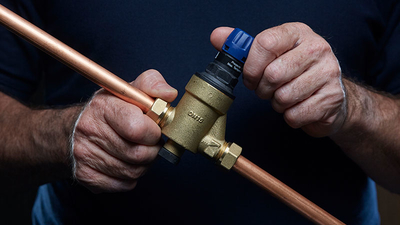Staging PRVs: When, Where, How and Why

Controlling water pressure is essential for ensuring the safety of a plumbing installation. And understanding the importance of where and how a pressure reducing valve (PRV) should be installed is extremely important for the optimum performance of high-pressure systems. Design considerations, such as pressure staging, are key to a functional and reliable installation. In this blog, we expand on our post on installing PRVs and look at the ins and outs of PRV staging, including best practice and product recommendations.

What are PRVs?
Put simply, pressure reducing valves (PRVs) take a high-pressure flow of water at the inlet, then reduce it to a lower pressure at the outlet as desired, under both flow and no-flow conditions.
All of RWC’s Reliance Valves PRVs are WRAS approved - this means that they have undergone independent third-party testing to ensure that they comply with the current UK water regulations. This also signifies that all non-metallic materials used within the manufacture of the valves have been verified as safe for potable water systems.
In larger water networks, with higher system pressures, PRV's can potentially cause very loud noises, as they work hard to reduce the extremely high inlet pressure to a safe outlet one. This can eventually lead to all sorts of problems after install, therefore it is important that PRV pressure staging is considered at design as a way of future proofing the system.
What does staging PRVs mean?
A pressure reducing valve can only reduce the pressure so much without risking the valve being potentially damaged. In fact, most PRVs have an operating ratio in which they can perform safely. For example, if a valve was to have an inlet pressure of 12 bar, and the ratio of the valve was 3:1, the lowest pressure it could safely output would be 4 bar. If too high of a demand is placed on the PRV, the valve is put at risk of cavitation, a process where the liquid passing through the valve forms into vapour and implodes – which over time erodes the valve material, further reducing the lifespan of the installation. And here is where staging a PRV becomes crucial, which essentially is the process of reducing a very high inlet pressure to a much lower one, so that the installation can run safely.

Where do you see PRV staging?
In addition to acting as control valves, pressure reducing valves also function as safety valves, ensuring that irregularities in inlet pressures or fluctuations upstream of the valve don't adversely affect the wider system. Domestic houses can typically have a water pressure of anywhere between 1 and 4 bar, so installers and designers consider it unnecessary to include it on some systems.
Commercial buildings such as apartment blocks, hospitals and shopping centres, however, require high inlet pressures so that the water can reach all parts of the building with pressures often exceeding 10 bar and even reaching as high as 20 bar. These are too high for most appliances to handle, such as taps and showers, which is why PRVs are needed as a form of control, to ensure over-pressurisation doesn't occur.
How is PRV staging performed?
Usually, a floor of an apartment building, or hospital, will have an initial PRV which can be referred to as the floor or initial PRV. These will take the original mains pressure and reduce it, for example from 12 bar to 6 bar. There is then another PRV that further reduces the pressure, so that it can be used by appliances – from 6 bar to 1, 2 or 3 bar. This type of application is called pressure staging. Instead of trying to reduce the pressure at once, the pressure is gradually decreased through the floor PRV and then again via the secondary PRV at the entry point to a flat or specific area of the system.
There are several reasons for staging PRVs like this. The most obvious is to avoid cavitation.
As mentioned, PRVs have a pressure ratio at which they can safely operate. In applications which exceed this ratio, performance and the lifetime of the valve is greatly affected. Although the pressure can be reduced, taking such a high inlet pressure to a really low outlet pressure causes the valve to throttle. As it does this, vibrations through the valve cause loud noises, which can lead to valve damage.
Another reason for staging PRVs as a good plumbing practice is the fact that it provides a second layer of protection. If there was to be an issue with the secondary valve in a staging system, then the pressure coming out of the appliance would have at least been reduced once by the floor valve. Appliances would then be emitting water with 6 bar pressure rather than water with 15+ bars of pressure.

Additional information about the staging of PRVs
As the water travels further and further up a building, naturally gravity is going to take its toll on the water pressure. The water may have travelled so far upwards that a floor’s inlet pressure is equal to water which has passed through an initial ‘floor valve’. Despite this, PRV staging should still be implemented as there is always the possibility of malfunctions with the initial water pump, which could result in higher inlet pressures than anticipated.
Among the PRVs offered by RWC’s Reliance Valves is the Commercial 315i series Pressure Reducing Valve. This valve has a viable inlet to outlet pressure ratio of 10:1 so it can feasibly reduce a water pressure of 20 bar to 2 bar without risk of cavitation. To find out more about Reliance Valves’ range of pressure reducing valves click here.
RWC’s team of technical experts are on hand to provide technical information and advice on installation best practice for commercial plumbing and heating applications. If you’ve got any questions, please contact us here.
Discover more
To find out about our wide range of PRVs, including options with push-fit, union and compression ends.
